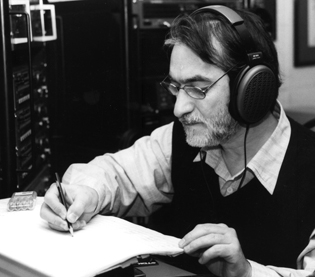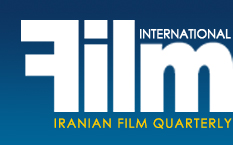|
Film music in the Iranian cinema:
An Independent Path in Cinema
by Habib Hekmat
|
 Iranians got to know cinema five years after its invention. For two or three decades, Iranian films were all silents. Abdolhossein Sepanta was the forerunner of sound films in Iran. Lor Girl, which was screened in Tehran in 1933, was the first sound movie of the Iranian cinema. It has been produced at Imperial Film Company of Bombay and had no score in the real sense of the word. It was important however, because it was screened just five years after the second sound film of the world, Lights of New York (Bryan Foy, 1928). How music found its way into the Iranian cinema? Iranians got to know cinema five years after its invention. For two or three decades, Iranian films were all silents. Abdolhossein Sepanta was the forerunner of sound films in Iran. Lor Girl, which was screened in Tehran in 1933, was the first sound movie of the Iranian cinema. It has been produced at Imperial Film Company of Bombay and had no score in the real sense of the word. It was important however, because it was screened just five years after the second sound film of the world, Lights of New York (Bryan Foy, 1928). How music found its way into the Iranian cinema?
The Grand Cinema was the first movie theater where new films were regularly screened every Monday and Friday. Ali Vakili, manager of the Grand Cinema and hotel, had arranged an orchestra for every film to attract people. Iranian music was played before screening, in the interlude, and during screening. A few years later, a gramophone was installed behind the curtains at Iran Cinema which played non-Iranian musical records both before and after screening. Ebrahim Moradi made Capricious in 1924 in which, like other silent movies, a player would perform musical pieces behind the curtain. The first Iranian film with score was Shirin and Farhad, which was produced by Abdolhossein Sepanta and whose score had been taken from the works of violin player, Mostafa Nouriani. Sepanta also made other films including Ferdowsi and Shirin and Farhad. Dialogues in the latter film were songs and it was almost a musical film. The fourth film made by Sepanta was Black Eyes (1936) with a theme by Amir Hosseini which had been produced in India. His last film, Leili and Majnoun (1937) had a theme composed by Ali Naqi Vaziri, a master of traditional Iranian music. After a 10-year interregnum, the Iranian cinema was ushered in a new period with The Storm of Life (1947) whose theme was the work of two famous Iranian composers, Ruhollah Khaleqi and Abolhassan Saba, based on the poems of the famous contemporary Iranian poet, Rahi Mo’ayyeri, sang by the renowned Iranian singer, Gholamhossein Banan. Up to 1960s, film music in the Iranian cinema was limited to songs which aimed to attract more audience and ranged from good musical works to commonplace ones. For a long time, film music in the form of singing and dancing (similar to the Indian films) was a major attraction for the Iranian films and, in fact, theme music in the sense that was common in the world cinema was not extant. The importance given to Persian songs caused many singers to begin a film career from early 1950s. Since its outset, film music was inspired by the Indian cinema and Persian films were awash with various kinds of songs and ballads. You could no longer find a film with less than a dozen songs in it. The male and female characters just started to sing with or without good excuse and in relation or without relation to the story. Viewers actually went to theaters to see and listen to the latest songs of that time’s singers which in most instances were accompanied by picture of the singer. Apart from that, Persian films availed of other effects like lip movements of the main actors. In this way, Iraj, Golpayegani, Vigen, Ahdiyeh and few other singers who were originally radio singes turned into the main singers of the Iranian cinema up to the Islamic Revolution and they also gave birth to that kind of singing and dancing which was common to cabarets. Professionally, however, the first theme music was composed by Morteza Hannaneh for Tigris in 1954. Those songs were sometimes supplemented by selected musical pieces in scenes without songs, which were closer to actual film music and the art of cinema. Rubik Mansouri, a sound specialist in the Iranian cinema, did this from early years after emergence of Persian films. He sometimes mixed some pieces of music and created a totally new one to be mounted on the film. He continued his career after the revolution. His work was sometimes better than original musical pieces put on most Iranian films. However, apart from that popular current, a different current was evolving in the Iranian cinema with a different type of music. Creators of those works sought to make films which would be closer to the spirit of cinema, on the one hand, and the spirit of the Iranian art, on the other hand. Since the late 1960s, their trial-and-error method proved successful and two influential films were made: The Cow by Dariush Mehrjui and Qaysar by Massoud Kimiaei. The theme of The Cow was composed by Hormoz Farhat and that of Qaysar was the work of Esfandiyar Monfaredzadeh. Each of those films not only left its mark on the Iranian cinema, but on the use of score music in Iran. The theme composed for The Cow was more compatible with the movie and richer in terms of musical structure and drew more attention from musical experts compared to Qaysar. Hormoz Farhat had used a number of Iranian instruments to compose the theme of The Cow which was more suitable for a rustic environment. The name of director, Dariush Mehrjui, has been mentioned in credits as dulcimer player. The musical theme of Qaysar, however, was more compatible with the public culture. The main theme of Qaysar’s story was based on the confrontation between good and evil and its tragic tone was more suitable for passion play music which is among traditional and religious performances in Iran. Monfaredzadeh, who had also experienced with pop music, combined the Iranian musical system called “Homayoun” with modern music with an eye on the works of Mikis Theodorakis (whose works were frequently used by Rubik Mansourian, the late composer of the Iranian cinema) and managed to create a musical theme which greatly changed the musical taste of the Iranian moviegoers. For many years to come, the theme of Qaysar was among three or four main models used for composing film music in Iran. After a short while, Monfaredzadeh experienced a new model in Reza the Motorcyclist which was used until the revolution and was revived in post-revolution cinema after one or two decades. In Reza the Motorcyclist, the composer had turned expanded form of melodies into film music because new wave stars of the Iranian cinema were not content to just move their lips as they did in the mainstream cinema. In fact, Qaysar owes a lot of its prominence to Monfaredzadeh’s music. Using an instrument, which was not common in the Iranian cinema and was a symbol of manliness, he made a quite different film and it should be admitted that use of music in the Iranian cinema to influence the audience had no precedence before that. Morteza Hannaneh, Mojtaba Mirzadeh, Babak Bayat, Ahmad Pezhman, Fereidoun Nasseri, Kambiz Roshanravan, Farhad Fakhreddini, and Majid Entezami were among the best composers of the Iranian cinema and television before the revolution and most of them continued their career following the Islamic Revolution in 1979.
SUBSCRIBE
[Page: 84]
|
|
|
|
|
President & Publisher
Massoud Mehrabi
Editors:
Sohrab Soori
Translators:
Sohrab Soori
Behrouz Tourani
Zohreh Khatibi
Saeed Khamoush
Contributors
Saeed Ghotbizadeh
Mehrzad Danesh
Advertisements
Mohammad Mohammadian
Art Director
Babak Kassiri
Ad Designers
Amir Kheirandish
Hossein Kheirandish
Cover Design
Alireza Amakchi
Correspondents
E.Emrani & M. Behraznia (Germany)
Mohammad Haghighat (France)
A. Movahed & M. Amini (Italy)
Robert Richter (Switzerland)
F. Shafaghi (Canada)
B. Pakzad (UAE)
H. Rasti (Japan)
Print Supervisors
Shad-Rang
Noghreh-Abi
Gol-Naghsh
Subscription & Advertising Sales
Address: 10, Sam St., Hafez Ave., TEHRAN, IRAN
Phone: +98 21 66722444
Fax: +98 21 66718871
info@film-magazine.com
Copyright: Film International
© All rights reserved,
2023, Film International
Quarterly Magazine (ISSN 1021-6510)
Editorial Office: 5th Floor, No. 12
Sam St., Hafez Ave., Tehran 11389, Iran
*
All articles represent views of their
authors and not necessarily
those of the editors
|
|
|

